Discussing the Role and Function of StackingDAO
Author: Do Dive, DeSpread
Disclaimer: The content of this report reflects the views of the respective authors, is for reference only, and does not constitute advice to buy or sell tokens or use protocols. Any content in this report does not constitute investment advice and should not be understood as such.
1. Overview of Liquidity Staking Services
In blockchain networks that adopt the Proof of Stake (PoS) consensus algorithm or similar mechanisms (such as Ethereum), to participate in the block validation process, a certain amount of native tokens must be staked. Although staking enhances the security of the chain by tying up a large amount of capital, it also brings about the problem of reduced capital efficiency as the staked funds cannot be used elsewhere.
Liquidity staking is introduced to solve this problem. The services it provides allow for the liquidity of staked assets to participate in the block validation process without losing liquidity. Liquidity staking services typically provide the following functions to enhance the capital efficiency of staked assets:
Tokenization of staked assets: When users stake assets through liquidity staking services, they receive derivative tokens corresponding to the staked assets (such as stETH).
Value guarantee and reward distribution: The derivative tokens ensure a 1:1 exchange with the underlying assets. Holders of these tokens can earn block validation rewards through mechanisms such as resets or exchange rate adjustments.
Utilization of liquidity and assets: Users can utilize the value of derivative tokens in various decentralized applications (dApps), such as using them as collateral for loans or providing liquidity in DeFi scenarios.
Participating in block validation on certain chains has a high barrier to entry. For example, becoming an Ethereum validator requires a capital investment of 32 ETH (worth over $10,000), and on Solana, validators must bear high hardware costs due to the high specifications of the chain.
Liquidity staking services address these barriers by allowing more users to participate in the block validation process, benefiting both the chain and users, including:
Enhanced security: More native tokens are staked, strengthening the security of the chain.
Improved capital efficiency: Users earn block validation rewards while using staked assets in DeFi.
1.1. Role of Liquidity Staking
Lido Finance, launched in December 2020, is a pioneer in liquidity staking services in the Ethereum ecosystem. After the Shanghai upgrade in 2023, the ability to extract ETH on the Beacon Chain was realized. With the market's recovery, the amount of ETH staked through regular investments in liquidity staking services has increased sharply.
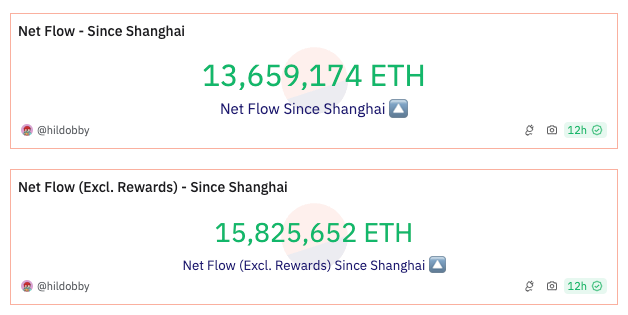
Source: @hildobby dune dashboard
According to the Dune dashboard provided by hildobby, as of the end of July 2024, approximately 15.8 million ETH were staked, exceeding the pre-upgrade 13.6 million ETH. These numbers demonstrate a sharp increase in demand for Ethereum staking in the 15 months after the Shanghai upgrade. Additionally, approximately 32.6% of Ethereum staking is processed through liquidity staking services, highlighting the significant role these services play in the on-chain ecosystem.

Total Value Locked (TVL) trend for all protocols, Source: Defillama

Liquidity staking TVL trend, Source: Defillama
According to DefiLlama's data, liquidity staking services account for over half of the Total Value Locked (TVL) in all protocols, demonstrating their dominant position. Lido Finance alone has the highest TVL among all protocols, at approximately $32.7 billion.
Key metrics as of August 1, 2024:
Total TVL: $991.6 billion
Liquidity staking TVL: $507 billion
Lido Finance TVL: $312 billion (ranked first among all protocols, with EigenLayer in second place at $155 billion)
Ethereum staked amount: approximately 34 million ETH
Utilization of liquid funds: approximately 11 million ETH (32.6% of total ETH staked)
1.2. Applicability to Other Chains
The success of liquidity staking services on the Ethereum chain has stimulated adoption on other chains, including Solana, Avalanche, and IBC-based chains. Some of these services have also achieved significant TVL, proving their practicality. Following Ethereum, Solana has become the second-largest chain in terms of liquidity staking services, with notable protocols including:
Jito / TVL: $18.4 billion
Marinade / TVL: $11 billion
Sanctum / TVL: $7.58 billion
These developments indicate the expanding influence of liquidity staking services in different blockchain ecosystems.
2. Transfer Proof of Stacks (PoX) and Liquidity Staking
Even chains that do not adopt the Proof of Stake (PoS) mechanism can create a favorable environment for liquidity staking protocols if their consensus mechanism involves token locking or delegation to validators. Stacks, which uses the Proof of Transfer (PoX) consensus mechanism, is an example of this.
The PoX algorithm in the Stacks blockchain is characterized by the interaction between miners and Stackers. Miners send Bitcoin (BTC) to Stackers to gain the right to create Stacks blocks and receive STX rewards. Stackers need to lock a certain amount of STX to receive BTC rewards. For more detailed information, please refer to "Stacks Nakamoto Upgrade, a Butterfly Ready to Stand Out".
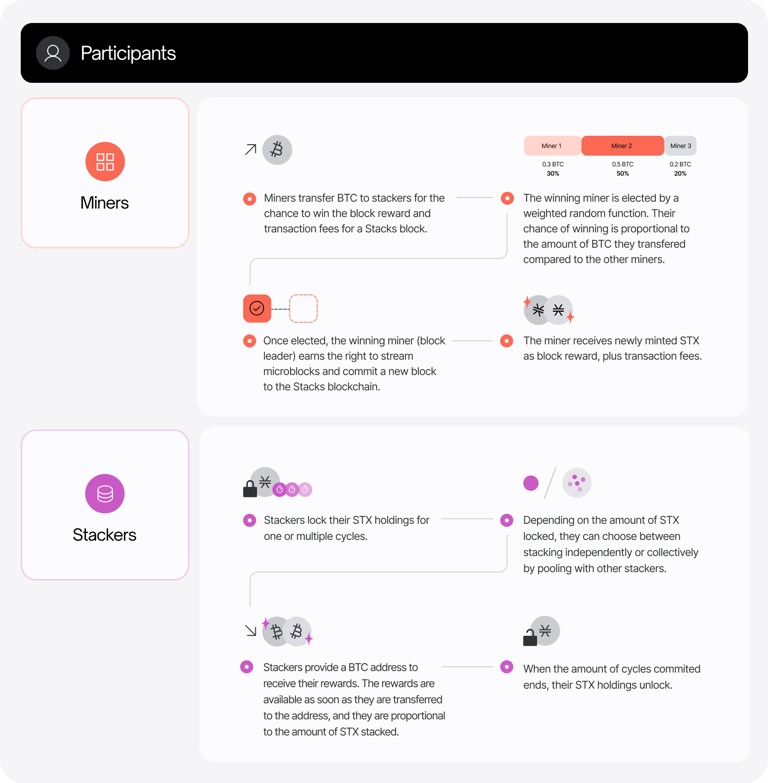
Roles of miners and Stackers, Source: stacks docs
- At the beginning, Stackers only needed to lock STX tokens to participate in the PoX process. However, after the Nakamoto upgrade planned for the second half of this year, Stackers will take on a new role called Signer. The Signer will be responsible for verifying, storing, signing, and propagating the Stacks blocks generated during the miner's term.
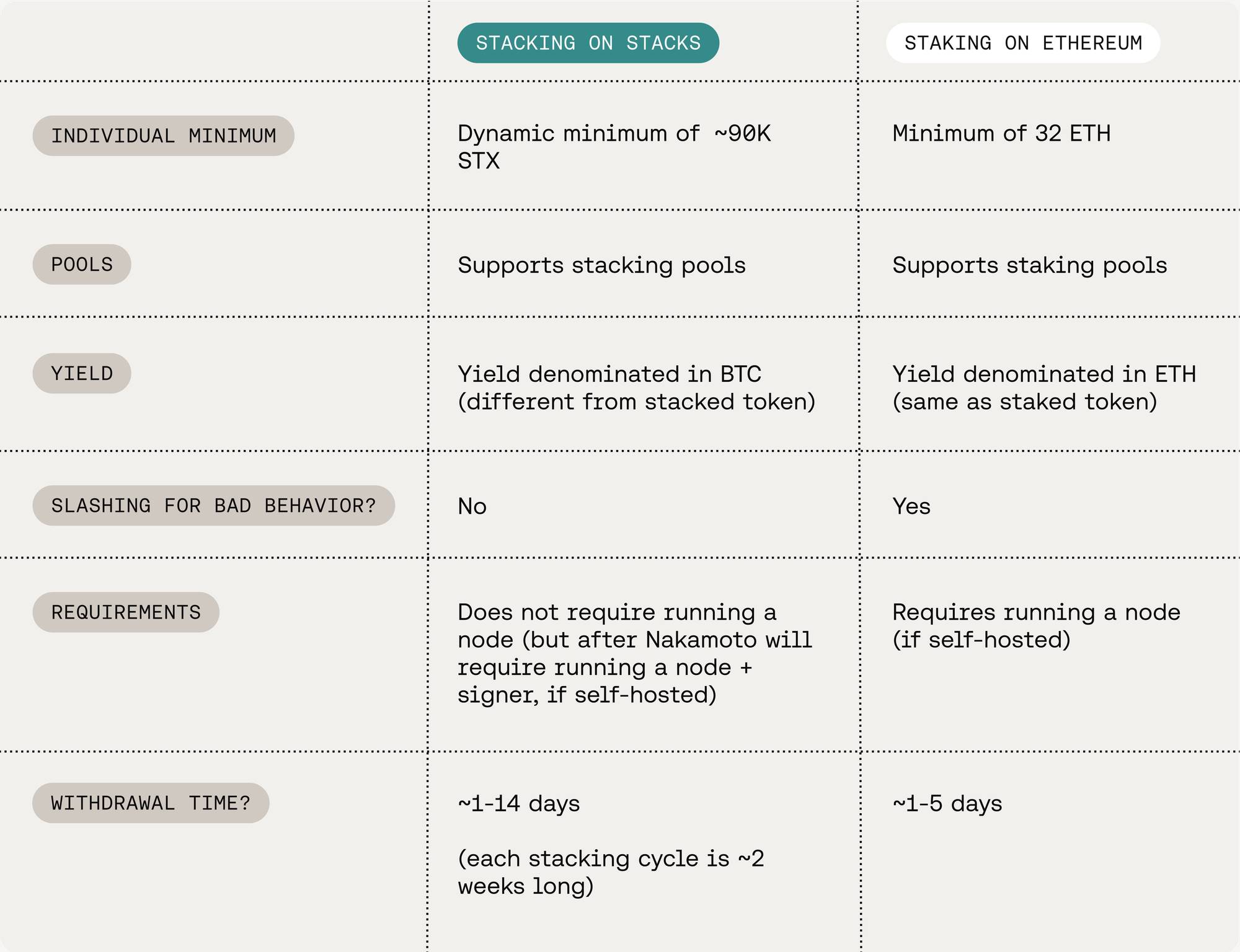
Stacking vs Staking, Source: Hiro blog
As shown in the image, the "Stacking" process in Stacks has similarities to the "Staking" process in Ethereum: 1) Both involve locking tokens to participate in on-chain consensus mechanisms; 2) Both require a large amount of native tokens, and after the Nakamoto upgrade, Stackers also need to run nodes, creating barriers to entry; 3) Both require locking assets for a certain period and setting a withdrawal period, reducing capital efficiency, highlighting the demand for liquidity staking services.
3. Liquidity Staking Service: StackingDAO
3.1. Role of Stacking Mechanism and StackingDAO
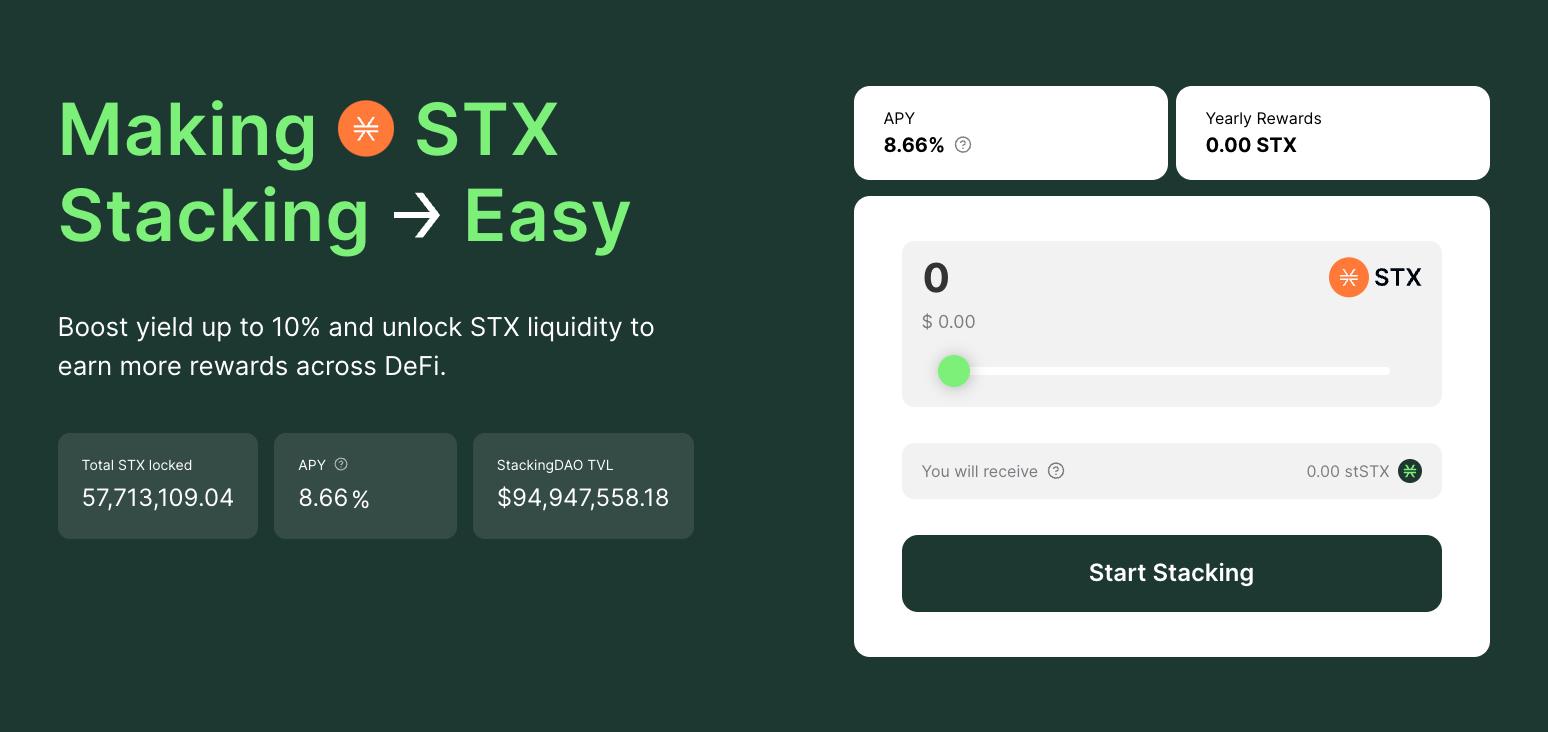
Source: StackingDAO
StackingDAO is a decentralized application (dApp) that provides liquidity staking services for the Stacking process on Stacks. Similar to other liquidity staking services, users can deposit their STX tokens into StackingDAO, participate in the Stacking process, and earn approximately 8% (benchmark 7%) annual percentage yield (APY) by receiving derivative tokens called stSTX.
The Stacking mechanism on Stacks is similar to the Staking process in Ethereum, both introducing challenging entry barriers:
Stacking Period: Stacking operates in two-week cycles, leading to time constraints for locking, unlocking, and restacking.
Minimum STX Requirement: Registering as a Stacker requires approximately 90,000 STX tokens.
Node Operations: After the Nakamoto upgrade, Stackers need to run nodes.
The two-week cycle brings inconvenience to users as they must lock or unlock their assets based on the cycle. Additionally, if a user wants to unlock only a portion of their assets, they must first unlock all assets and then restack the remaining portion, adding complexity.
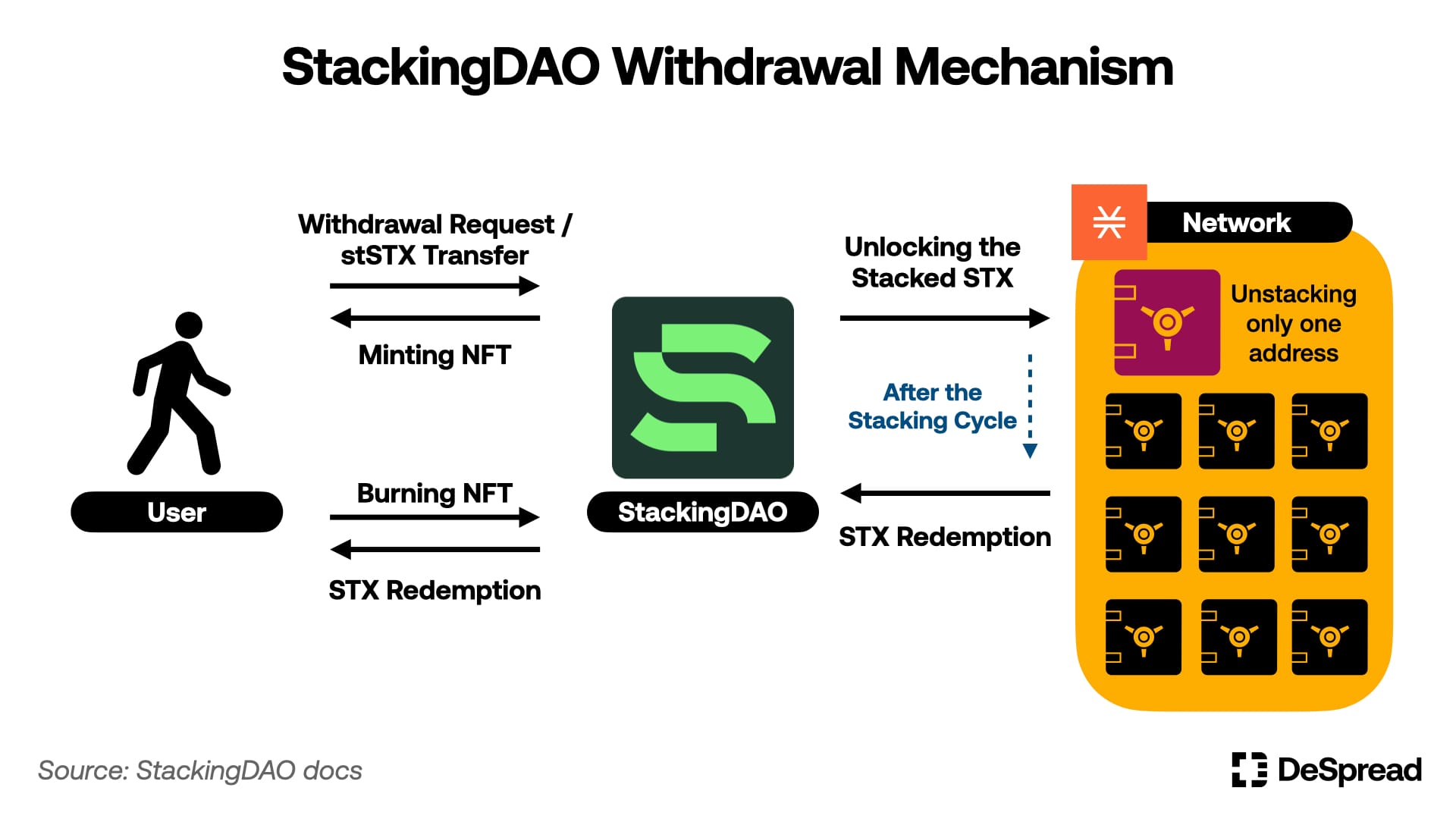
To address these challenges, StackingDAO has designed an exit mechanism to reduce entry barriers and minimize the impact on Stacking yields. Its main features include:
Diversified Stacking Addresses: StackingDAO allocates STX to 10 different Stacking addresses to mitigate the impact on yields.
Interleaved Withdrawals: Only one of the 10 addresses is unlocked in each Stacking cycle, allowing for interleaved withdrawals based on user requests.
Issuance of NFTs: When users request a withdrawal, they send stSTX to the protocol, which issues NFTs as receipts. After the Stacking cycle ends, users can burn the NFTs to exchange the unlocked STX tokens.
This mechanism reduces time constraints and inconveniences in the Stacking process, ensuring that users can flexibly access and utilize their assets while maintaining Stacking yields.
3.2. Growth and Key Metrics
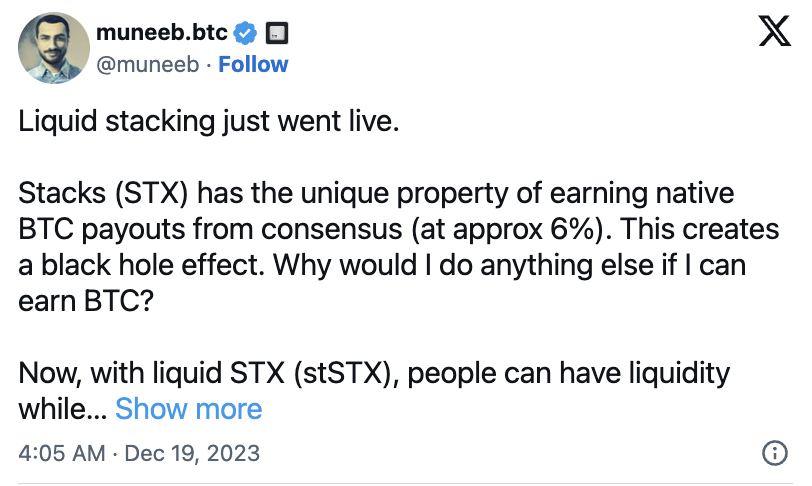
Muneeb announces the launch of StackingDAO, Source: Muneeb X
Since its launch in December 2023, StackingDAO has effectively gained attention and attracted rapid growth of users and capital by introducing a point system. The point system rewards users daily based on their holdings of stSTX, encouraging stSTX to be used in DeFi protocols:
- 1 point is rewarded for each stSTX token held
- 1.5 points are rewarded for each stSTX token deposited into DeFi protocols
- 2.5 points are rewarded for each stSTX token deposited into the Bitflow stable exchange pool
Key metrics as of August 21, 2024:
- Total issued stSTX: approximately 56.8 million
- DeFi utilization rate of stSTX: 45%
- TVL of stSTX in DeFi: $36.78 million
- Total points issued: approximately 14.95 billion
- Total number of users: 37,498
As the first liquidity staking dApp in the Stacks ecosystem, StackingDAO reached a peak TVL of nearly $125 million shortly after its launch. Despite market adjustments, StackingDAO's TVL remains around $80 million, making it the largest dApp in terms of funds in the Stacks ecosystem.

Stacks dApp TVL ranking, Source: Defillama
Bitflow is a stable trading protocol that benefits from the launch of StackingDAO and the introduction of the point system. Currently, approximately 10.5 million STX tokens are deposited in the protocol, demonstrating its growth momentum.
The TVL of StackingDAO, calculated in STX tokens, has been on the rise since its launch and currently stands at approximately 58 million tokens. This accounts for about 4% of the total circulating supply of 1.48 billion STX tokens and approximately 13% of the current 425 million STX tokens participating in Stacking. Considering that this dApp has been launched for less than a year, this is a quite significant data.
3.3. Contribution to the Stacks Network: StackingDAO V2
Starting from late August, as the activation phase of the Nakamoto upgrade unfolds, Stackers will transition to the role of Signer responsible for verifying Stacks blocks. The Signer is similar to validators in Proof of Stake (PoS) chains, and therefore, enhancing the stability and diversity of the Signer network becomes a key goal after the Nakamoto upgrade to improve the security and decentralization of the Stacks blockchain.
In this context, StackingDAO has launched StackingDAO V2, aimed at simplifying the process of joining as a Signer. A major feature of this update is delegating the STX tokens deposited into StackingDAO to the new signers on the Stacks blockchain, thereby promoting the growth of the network. This update was initially announced in March and is planned to be implemented after the completion of the Nakamoto upgrade.
StackingDAO V2 is built around a mechanism where the STX tokens deposited by users into the protocol are proportionally delegated to Signers based on their performance. This design aims to achieve the following objectives:
- Improve network performance: Delegating STX staking amounts to different Signers to enhance the diversity of the Signer network and incentivize Signers to improve their performance.
- Increase user rewards: More STX staking amounts will be delegated to Signers with higher performance, providing users with higher compounded returns.
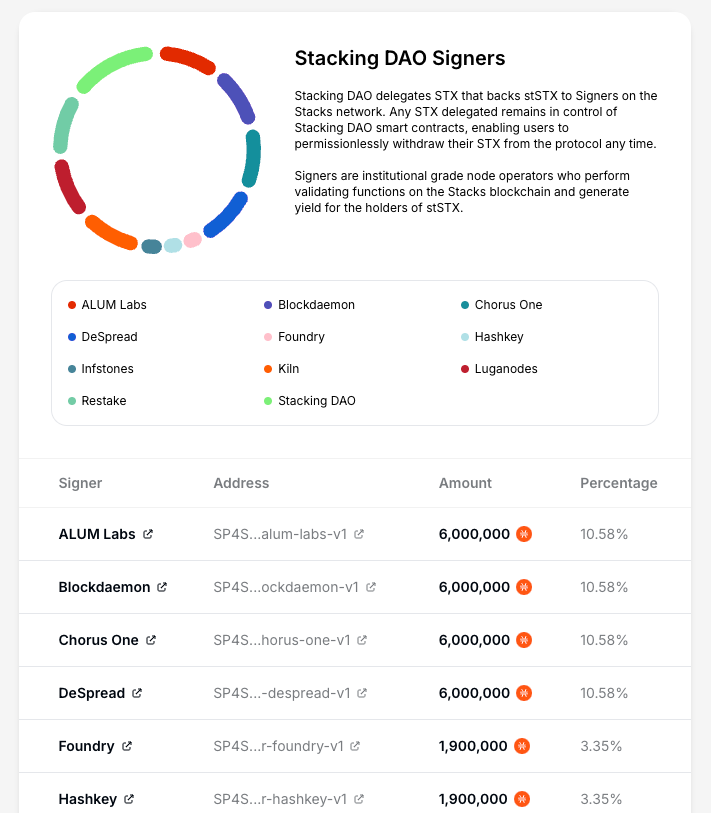
Status of Signers joined in StackingDAO, Source: StackingDAO
Even before the full activation of the Nakamoto upgrade, 10 entities (excluding StackingDAO) have already joined the Signer program of StackingDAO, and delegation amounts have been allocated to these Signers since May. After the release of the Nakamoto upgrade, the scope of joining Signers through StackingDAO is expected to expand, further enhancing the diversity of the Signer network.
4. Conclusion
At the beginning of this year, with the surge in interest in the Bitcoin ecosystem, the Stacks network and other projects have also received significant attention. This attention has driven the growth of the total value locked (TVL) in the Stacks network, reaching a peak of $180 million in April, an 18-fold increase compared to the $10 million TVL recorded in September of the previous year.
However, as the market entered a correction phase, a series of challenges emerged within the Stacks ecosystem. These include the delay of the Nakamoto upgrade and the hacking incident at Alex, the largest decentralized exchange in the Stacks ecosystem. Despite these setbacks, emerging projects such as StackingDAO, Zest, Bitflow, and LISA continue to accumulate TVL and achieve growth. With the Nakamoto upgrade set to be completed in September, the market is once again optimistic about the future of the Stacks ecosystem.

Source: Hiro blog
As the Nakamoto upgrade is about to be realized, the evolution of the Stacks ecosystem is worth observing, and it remains to be seen how StackingDAO, with the largest TVL in the ecosystem, will develop. The success of StackingDAO as a liquidity magnet in Stacks DeFi will be a key focus in the coming months.
免责声明:本文章仅代表作者个人观点,不代表本平台的立场和观点。本文章仅供信息分享,不构成对任何人的任何投资建议。用户与作者之间的任何争议,与本平台无关。如网页中刊载的文章或图片涉及侵权,请提供相关的权利证明和身份证明发送邮件到support@aicoin.com,本平台相关工作人员将会进行核查。




